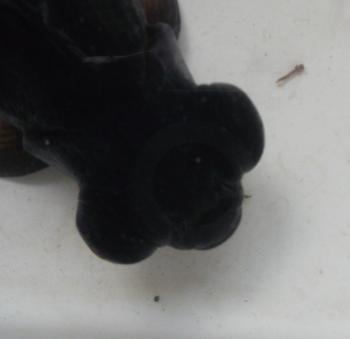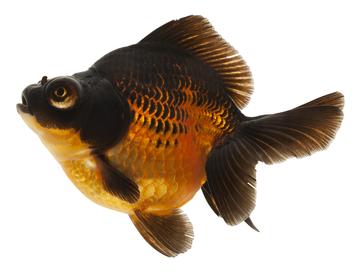Choosing Goldfish For Breeding
When you decide to start your own goldfish dynasty, you should breed the best quality fish available.
 High quality Ryukin Goldfish
High quality Ryukin GoldfishBy quality fish, I mean choosing goldfish for breeding that have characteristics such as caudal fin size and body shape that follow the variety’s recognized standards closely.
The higher the quality of your breeders, the quicker it is to produce prize winning fish.
The ideal situation would be to have 1000 three month old fish to choose your breeders from.
The reality is you may only have the fish that are available at your local pet store to choose from.
When you breed fancy goldfish, you soon learn that some characteristics are easier to produce than others. I will use Black Moor as an example. High quality specimens should have the following characteristics:
- Velvety black coloration without any brassiness in the lower body
- Large protruding eyes of even size
- Deep body shape with no physical deformities
- All fins present with no deformities
- Two caudal (tail) fins, fully divided, veil tail with little or no fork
- Two anal fins.
Prize winning fish go to the next level with different physical features being compulsory such as body depth to dorsal height. You would be extremely lucky to be able to purchase a fish with prize winning potential, so we must select from what is available and breed our own prize winners.
So what does this all mean…?
It means some faults on a fish can be acceptable if the fish is displaying another characteristic that is hard to attain.
If we take the above example of Black Moor, some of the 6 characteristics are more important than others when choosing goldfish for breeding.
Starting with the least important characteristic, I explain why a characteristic may be overlooked in favor of a more important one.
Two Anal Fins
It is quite difficult to see if two anal fins are present when culling small goldfish. This is usually one of the last faults goldfish are culled for. From a brood of 100 high quality juveniles, you may get one third that has a single anal fin. This means 70 will have the required twin anal fins.
Based on these figures, twin anal fins are an easy characteristic
to get from a spawning. I wouldn’t reject an otherwise high quality fish
because of this fault, If other available fish
with twin anal fins are of a lower quality.
Two Caudal Fins Fully Divided, Veil Tail With Little Or No Fork

The earliest culls of fancy goldfish fry are for single tails where two should be present. A bad cull rate would be 30 fry out of 100 rejected. The 70 left will need further culls later for incomplete separation of the tails, uneven sizes or incorrect shape which will show up as they get bigger.
After these culls there should be 3 to 5 juveniles out of 100 worth growing on. Based on these figures, you have a good chance of getting 15-25 individuals from a spawning of 500.
I would select the fish with the best caudal fin separation and shape. The fish shown here has an incomplete division of the caudal fins, but the fins have good shape and are the same size.
All Fins Present With No Deformities
Once fry are a month old, all fins should be present, with no deformities.
Missing fins are a genetic problem and don’t occur that often. One or two fish in every 100 would be an exception. Deformed caudal fins are more common. Any other deformed fin, unless damaged, is also a genetic problem.
When choosing goldfish for breeding don’t use fish with genetic problems. The problem seems to show up more severely with each succeeding generation.
Large Protruding Eyes Of Even Size


Some Black Moor fail to develop telescopic eyes. The eyes start to protrude, then stop. On others the eyes can develop unevenly. Very few Black Moor develop small telescopic eyes. 10 out of 100 would be considered high.
If you are forced to use a fish with small or under-developed eyes, be prepared to have a high cull rate. I would avoid these fish if possible. Fish with uneven eye development are less common. As long as both eyes have good development, it shouldn’t cause too many reject problems.
As examples of different eye development, the Moor on the left above has good, reasonably even eye development. The Moor on the right has far less eye development. I wouldn't use a fish with eyes smaller than this otherwise your culled numbers will be too high.
Velvety Black Coloration

Coloration is an important characteristic when choosing Black Moor. The deeper and more velvety the black is the better. Inferior specimens can be quite brassy when viewed from the side, especially in the lower belly region. These fish tend to change color in later life.
If you use these fish as breeders, you will have a high cull rate, perhaps 50% or more. Culling for color intensity is one of the last culls you do for Black Moor so you won’t have that many fish to choose from.
What you are looking for are fish with white or silvery ventral (belly) areas as seen on the fish here.
Deep Body Shape With No Deformities

This characteristic to me is the most important, and the hardest to attain.
Most commercial grade fish have bodies that are too long. Some say this is because they are raised in large ponds.
If you can select breeders with the required deep bodies, you will very quickly be producing prize winning fish. If you breed long bodied fish, the majority of fry will be long bodied. If a few fry do develop deep bodies, the likelihood of them exhibiting all the other desired characteristics is low. You would need to raise an entire spawn, maybe only culling for single tails, then grow them up to a size big enough so you can separate the few good specimens.
This is impractical for most breeders.
The conclusion is really this, focus on the hard to attain physical characteristics first before rejecting a fish because it has a small fault such as only one anal fin.
Tip:
Be wary of young fish displaying advanced development such as well developed fins. These fish are usually undersized when compared to their siblings and often don’t reach maturity.
Young goldfish put most of their energy into growth, not growing large fins. That starts after growth slows or stops.
Experienced goldfish keepers will always choose a young fish displaying good early development of the required characteristics over a young fish that is showing advanced development.
The young fish with advanced development, for some reason, has stopped growing.
Top of Choosing Goldfish For Breeding page




